


참고
Go to the end to download the full example code.
wav2vec2을 이용한 강제 정렬#
이번 튜토리얼에서는 CTC-Segmentation of Large Corpora for German End-to-end Speech Recognition 에서 설명한 CTC 분할 알고리즘을 이용하여 torchaudio를 가지고 정답 스크립트를 음성에 맞추는 방법에 대해 설명합니다.
참고
이 튜토리얼은 원래 Wav2Vec2의 사용 사례를 설명하기 위해 작성되었습니다.
TorchAudio에는 강제 정렬을 위해 설계된 API가 있습니다.
CTC forced alignment API tutorial 은 핵심 API인
torchaudio.functional.forced_align() 의 사용법에 대해 보여주고 있습니다.
만약 본인만의 코퍼스에 대해 강제 정렬하려는 경우, torchaudio.pipelines.Wav2Vec2FABundle 를 사용하는 것을 추천합니다.
이는 강제 정렬을 위해 특별히 훈련된 사전 훈련 모델과 함께 forced_align() 및 여러 함수를 결합하여 사용할 수 있게 합니다.
사용법에 대한 자세한 내용은 다국어 데이터를 위한 강제 정렬을 설명하는 Forced alignment for multilingual data 를 참조하세요.
import torch
import torchaudio
print(torch.__version__)
print(torchaudio.__version__)
device = torch.device("cuda" if torch.cuda.is_available() else "cpu")
print(device)
2.8.0+cu128
2.8.0+cu128
cuda
개요#
정렬 과정은 다음과 같습니다.
오디오 파형으로부터 프레임별 라벨 확률을 추정한다.
각 시간 별로 정렬된 라벨의 확률을 나타내는 trellis 행렬을 생성한다.
trellis 행렬로부터 가장 가능성이 높은 경로를 찾는다.
이번 예시에는 음성 특징 추출을 위해 torchaudio의 wav2vec2 모델을 사용합니다.
준비#
먼저 필요한 패키지를 임포트하고, 작업할 데이터를 불러옵니다.
from dataclasses import dataclass
import IPython
import matplotlib.pyplot as plt
torch.random.manual_seed(0)
SPEECH_FILE = torchaudio.utils.download_asset("tutorial-assets/Lab41-SRI-VOiCES-src-sp0307-ch127535-sg0042.wav")
/workspace/tutorials-kr/intermediate_source/forced_alignment_with_torchaudio_tutorial.py:62: UserWarning:
torchaudio.utils.download.download_asset has been deprecated. This deprecation is part of a large refactoring effort to transition TorchAudio into a maintenance phase. Please see https://github.com/pytorch/audio/issues/3902 for more information. It will be removed from the 2.9 release.
0%| | 0.00/106k [00:00<?, ?B/s]
100%|██████████| 106k/106k [00:00<00:00, 17.1MB/s]
프레임 별 라벨 확률 생성#
첫번째 과정은 각 오디오 프레임 별 라벨 클래스 확률을 생성하는 것입니다.
ASR(음성 인식)용으로 학습된 wav2vec2 모델을 사용할 수 있습니다.
여기서는 torchaudio.pipelines.WAV2VEC2_ASR_BASE_960H() 를 사용합니다.
``torchaudio``는 연관된 라벨과 함께 미리 학습된 모델에 쉽게 접근할 수 있게 합니다.
참고
여기서는 수치적인 불안정성을 피하고자 로그 도메인에서 확률을 계산할 것입니다.
이렇게 하기 위해 torch.log_softmax() 를 사용하여 출력 확률 을 정규화합니다.
bundle = torchaudio.pipelines.WAV2VEC2_ASR_BASE_960H
model = bundle.get_model().to(device)
labels = bundle.get_labels()
with torch.inference_mode():
waveform, _ = torchaudio.load(SPEECH_FILE)
emissions, _ = model(waveform.to(device))
emissions = torch.log_softmax(emissions, dim=-1)
emission = emissions[0].cpu().detach()
print(labels)
Downloading: "https://download.pytorch.org/torchaudio/models/wav2vec2_fairseq_base_ls960_asr_ls960.pth" to /root/.cache/torch/hub/checkpoints/wav2vec2_fairseq_base_ls960_asr_ls960.pth
0%| | 0.00/360M [00:00<?, ?B/s]
1%|▏ | 5.25M/360M [00:00<00:06, 55.0MB/s]
4%|▍ | 15.0M/360M [00:00<00:04, 82.5MB/s]
7%|▋ | 25.5M/360M [00:00<00:03, 94.8MB/s]
10%|█ | 36.4M/360M [00:00<00:03, 102MB/s]
13%|█▎ | 47.5M/360M [00:00<00:03, 107MB/s]
16%|█▋ | 58.6M/360M [00:00<00:02, 110MB/s]
19%|█▉ | 69.2M/360M [00:00<00:02, 110MB/s]
22%|██▏ | 80.0M/360M [00:00<00:02, 111MB/s]
25%|██▌ | 91.0M/360M [00:00<00:02, 112MB/s]
29%|██▊ | 103M/360M [00:01<00:02, 117MB/s]
32%|███▏ | 114M/360M [00:01<00:02, 113MB/s]
35%|███▍ | 125M/360M [00:01<00:02, 113MB/s]
38%|███▊ | 136M/360M [00:01<00:02, 114MB/s]
41%|████▏ | 149M/360M [00:01<00:01, 118MB/s]
44%|████▍ | 160M/360M [00:01<00:01, 113MB/s]
48%|████▊ | 171M/360M [00:01<00:01, 114MB/s]
51%|█████ | 182M/360M [00:01<00:01, 114MB/s]
54%|█████▎ | 193M/360M [00:01<00:01, 114MB/s]
57%|█████▋ | 204M/360M [00:01<00:01, 115MB/s]
60%|█████▉ | 216M/360M [00:02<00:01, 112MB/s]
63%|██████▎ | 226M/360M [00:02<00:01, 109MB/s]
66%|██████▌ | 237M/360M [00:02<00:01, 105MB/s]
69%|██████▊ | 247M/360M [00:02<00:01, 101MB/s]
71%|███████▏ | 257M/360M [00:02<00:01, 95.2MB/s]
74%|███████▍ | 266M/360M [00:02<00:01, 89.9MB/s]
76%|███████▌ | 275M/360M [00:02<00:01, 87.8MB/s]
79%|███████▊ | 283M/360M [00:02<00:00, 86.7MB/s]
81%|████████ | 292M/360M [00:02<00:00, 87.1MB/s]
83%|████████▎ | 300M/360M [00:03<00:00, 87.2MB/s]
86%|████████▌ | 308M/360M [00:03<00:00, 84.4MB/s]
88%|████████▊ | 318M/360M [00:03<00:00, 89.2MB/s]
91%|█████████ | 328M/360M [00:03<00:00, 94.0MB/s]
94%|█████████▍| 338M/360M [00:03<00:00, 95.5MB/s]
97%|█████████▋| 349M/360M [00:03<00:00, 101MB/s]
100%|██████████| 360M/360M [00:03<00:00, 106MB/s]
100%|██████████| 360M/360M [00:03<00:00, 103MB/s]
/opt/conda/lib/python3.11/site-packages/torchaudio/_backend/utils.py:213: UserWarning:
In 2.9, this function's implementation will be changed to use torchaudio.load_with_torchcodec` under the hood. Some parameters like ``normalize``, ``format``, ``buffer_size``, and ``backend`` will be ignored. We recommend that you port your code to rely directly on TorchCodec's decoder instead: https://docs.pytorch.org/torchcodec/stable/generated/torchcodec.decoders.AudioDecoder.html#torchcodec.decoders.AudioDecoder.
/opt/conda/lib/python3.11/site-packages/torchaudio/_backend/ffmpeg.py:88: UserWarning:
torio.io._streaming_media_decoder.StreamingMediaDecoder has been deprecated. This deprecation is part of a large refactoring effort to transition TorchAudio into a maintenance phase. The decoding and encoding capabilities of PyTorch for both audio and video are being consolidated into TorchCodec. Please see https://github.com/pytorch/audio/issues/3902 for more information. It will be removed from the 2.9 release.
('-', '|', 'E', 'T', 'A', 'O', 'N', 'I', 'H', 'S', 'R', 'D', 'L', 'U', 'M', 'W', 'C', 'F', 'G', 'Y', 'P', 'B', 'V', 'K', "'", 'X', 'J', 'Q', 'Z')
시각화#
def plot():
fig, ax = plt.subplots()
img = ax.imshow(emission.T)
ax.set_title("Frame-wise class probability")
ax.set_xlabel("Time")
ax.set_ylabel("Labels")
fig.colorbar(img, ax=ax, shrink=0.6, location="bottom")
fig.tight_layout()
plot()
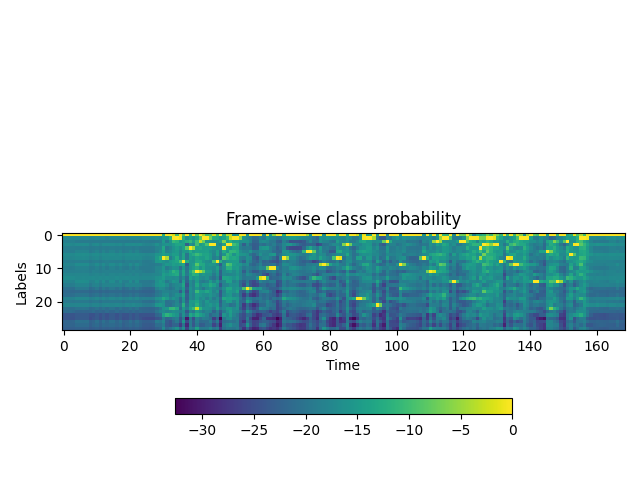
정렬 확률 생성 (trellis)#
다음, 출력 행렬로부터 각 프레임에서 정답 스크립트의 라벨들이 등장할 수 있는 확률을 나타내는 trellis를 생성합니다. Trellis는 시간 축과 라벨 축을 가지고 있는 2D 행렬입니다. 라벨 축은 정렬하려는 정답 스크립트를 나타냅니다. \(t\) 를 시간 축에서의 인덱스로 나타내는 데 사용하고, \(j\) 를 라벨 축에서의 인덱스로 나타내는 데 사용합니다. \(c_j\) 는 라벨 인덱스 \(j\) 에서의 라벨을 나타냅니다.
\(t+1\) 시점에서의 확률을 생성하기 위해, \(t\) 시점에서의 trellis와 \(t+1\) 시점에서의 출력을 봅니다. \(t+1\) 시점에서 \(c_{j+1}\) 라벨에 도달할 수 있는 2개의 경로가 있습니다. 첫번째는 \(t\) 시점에서 라벨은 \(c_{j+1}\) 였으며 \(t\) 에서 \({t+1}\) 으로 바뀔 때 라벨 변화는 없는 경우입니다. 다른 경우는 \(t\) 시점에서 라벨은 \(c_j\) 였으며 \(t+1\) 시점에서는 다음 라벨 \(c_{j+1}\) 로 전이된 경우입니다.
아래 그림은 2가지 전이를 나타내고 있습니다.
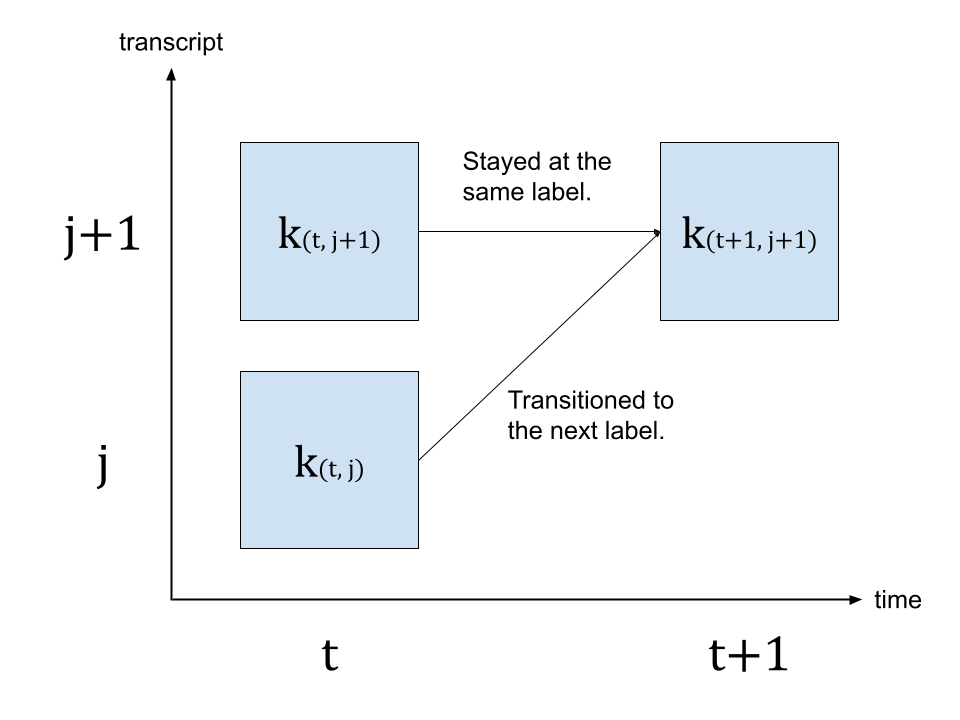
가장 가능성 있는 전이를 찾기 위해, \(k_{(t+1, j+1)}\) 의 값의 가장 가능성 있는 경로를 택합니다. 이는 아래에 나와 있는 식으로 나타낼 수 있습니다.
\(k_{(t+1, j+1)} = max( k_{(t, j)} p(t+1, c_{j+1}), k_{(t, j+1)} p(t+1, repeat) )\)
\(k\) 는 trellis 행렬을 나타내며, \(p(t, c_j)\) 는 \(t\) 시점에서의 라벨 \(c_j\) 의 확률을 나타냅니다. repeat는 CTC 식에서의 블랭크 토큰을 나타냅니다. (CTC 알고리즘에 대한 자세한 설명은 ‘Sequence Modeling with CTC’를 참고하세요.) [distill.pub])
# SOS와 EOS를 나타내는 space 토큰을 가지고 정답 스크립트를 둘러쌈.
transcript = "|I|HAD|THAT|CURIOSITY|BESIDE|ME|AT|THIS|MOMENT|"
dictionary = {c: i for i, c in enumerate(labels)}
tokens = [dictionary[c] for c in transcript]
print(list(zip(transcript, tokens)))
def get_trellis(emission, tokens, blank_id=0):
num_frame = emission.size(0)
num_tokens = len(tokens)
trellis = torch.zeros((num_frame, num_tokens))
trellis[1:, 0] = torch.cumsum(emission[1:, blank_id], 0)
trellis[0, 1:] = -float("inf")
trellis[-num_tokens + 1 :, 0] = float("inf")
for t in range(num_frame - 1):
trellis[t + 1, 1:] = torch.maximum(
# 같은 토큰에 머무르고 있는 경우의 점수
trellis[t, 1:] + emission[t, blank_id],
# 다음 토큰으로 바뀌는 경우에 대한 점수
trellis[t, :-1] + emission[t, tokens[1:]],
)
return trellis
trellis = get_trellis(emission, tokens)
[('|', 1), ('I', 7), ('|', 1), ('H', 8), ('A', 4), ('D', 11), ('|', 1), ('T', 3), ('H', 8), ('A', 4), ('T', 3), ('|', 1), ('C', 16), ('U', 13), ('R', 10), ('I', 7), ('O', 5), ('S', 9), ('I', 7), ('T', 3), ('Y', 19), ('|', 1), ('B', 21), ('E', 2), ('S', 9), ('I', 7), ('D', 11), ('E', 2), ('|', 1), ('M', 14), ('E', 2), ('|', 1), ('A', 4), ('T', 3), ('|', 1), ('T', 3), ('H', 8), ('I', 7), ('S', 9), ('|', 1), ('M', 14), ('O', 5), ('M', 14), ('E', 2), ('N', 6), ('T', 3), ('|', 1)]
시각화#
def plot():
fig, ax = plt.subplots()
img = ax.imshow(trellis.T, origin="lower")
ax.annotate("- Inf", (trellis.size(1) / 5, trellis.size(1) / 1.5))
ax.annotate("+ Inf", (trellis.size(0) - trellis.size(1) / 5, trellis.size(1) / 3))
fig.colorbar(img, ax=ax, shrink=0.6, location="bottom")
fig.tight_layout()
plot()
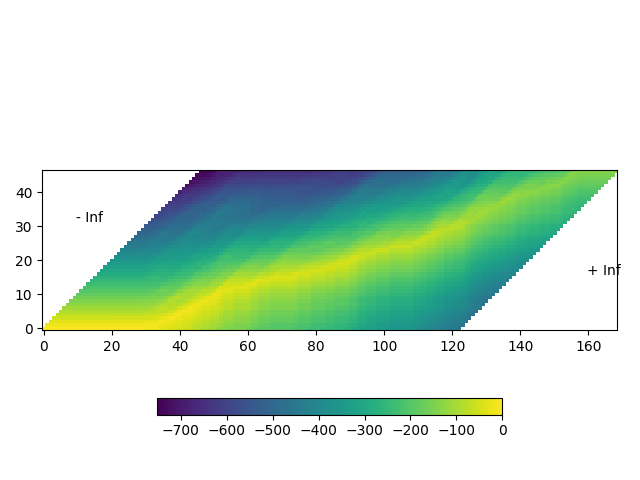
위 시각화된 그림에서, 행렬을 대각선으로 가로지르는 높은 확률의 추적(trace)를 볼 수 있습니다.
가장 가능성 높은 경로 찾기 (백트래킹)#
trellis가 한번 생성되면, 높은 확률을 가지는 요소를 따라 이를 탐색할 수 있습니다.
가장 높은 확률을 가지는 시간 단계에서 마지막 라벨 인덱스로부터 시작합니다. 그 후에, 이전 전이 확률 \(k_{t, j} p(t+1, c_{j+1})\) 또는 \(k_{t, j+1} p(t+1, repeat)`에 기반하여 머무를지 (:math:`c_j \rightarrow c_j\)) 또는 전이할지 (\(c_j \rightarrow c_{j+1}\))를 시간 역순으로 진행합니다.
라벨이 한번 시작 부분에 도달하게 되면, 전이가 수행됩니다.
trellis 행렬은 경로를 찾기 위해 사용되지만, 각 분할의 최종 확률에 대해서는 출력 행렬에서의 프레임별 확률을 사용합니다.
@dataclass
class Point:
token_index: int
time_index: int
score: float
def backtrack(trellis, emission, tokens, blank_id=0):
t, j = trellis.size(0) - 1, trellis.size(1) - 1
path = [Point(j, t, emission[t, blank_id].exp().item())]
while j > 0:
# 발생하지 않는 경우지만, 혹시 몰라 예외 처리함.
assert t > 0
# 1. 현재 위치가 stay인지 또는 change인지를 판단함.
# stay 대 change의 프레임 별 점수 계산
p_stay = emission[t - 1, blank_id]
p_change = emission[t - 1, tokens[j]]
# stay 대 change의 문맥을 고려한 점수 계산
stayed = trellis[t - 1, j] + p_stay
changed = trellis[t - 1, j - 1] + p_change
# 위치 갱신
t -= 1
if changed > stayed:
j -= 1
# 프레임별 확률을 이용하여 경로를 저장함.
prob = (p_change if changed > stayed else p_stay).exp().item()
path.append(Point(j, t, prob))
# 지금 j == 0이라면 이는, SoS를 도달했다는 것을 의미함.
# 시각화를 위해 나머지 부분을 채움.
while t > 0:
prob = emission[t - 1, blank_id].exp().item()
path.append(Point(j, t - 1, prob))
t -= 1
return path[::-1]
path = backtrack(trellis, emission, tokens)
for p in path:
print(p)
Point(token_index=0, time_index=0, score=0.9999996423721313)
Point(token_index=0, time_index=1, score=0.9999996423721313)
Point(token_index=0, time_index=2, score=0.9999996423721313)
Point(token_index=0, time_index=3, score=0.9999996423721313)
Point(token_index=0, time_index=4, score=0.9999996423721313)
Point(token_index=0, time_index=5, score=0.9999996423721313)
Point(token_index=0, time_index=6, score=0.9999996423721313)
Point(token_index=0, time_index=7, score=0.9999996423721313)
Point(token_index=0, time_index=8, score=0.9999998807907104)
Point(token_index=0, time_index=9, score=0.9999996423721313)
Point(token_index=0, time_index=10, score=0.9999996423721313)
Point(token_index=0, time_index=11, score=0.9999998807907104)
Point(token_index=0, time_index=12, score=0.9999996423721313)
Point(token_index=0, time_index=13, score=0.9999996423721313)
Point(token_index=0, time_index=14, score=0.9999996423721313)
Point(token_index=0, time_index=15, score=0.9999996423721313)
Point(token_index=0, time_index=16, score=0.9999996423721313)
Point(token_index=0, time_index=17, score=0.9999996423721313)
Point(token_index=0, time_index=18, score=0.9999998807907104)
Point(token_index=0, time_index=19, score=0.9999996423721313)
Point(token_index=0, time_index=20, score=0.9999996423721313)
Point(token_index=0, time_index=21, score=0.9999996423721313)
Point(token_index=0, time_index=22, score=0.9999996423721313)
Point(token_index=0, time_index=23, score=0.9999997615814209)
Point(token_index=0, time_index=24, score=0.9999998807907104)
Point(token_index=0, time_index=25, score=0.9999998807907104)
Point(token_index=0, time_index=26, score=0.9999998807907104)
Point(token_index=0, time_index=27, score=0.9999998807907104)
Point(token_index=0, time_index=28, score=0.9999985694885254)
Point(token_index=0, time_index=29, score=0.9999943971633911)
Point(token_index=0, time_index=30, score=0.9999842643737793)
Point(token_index=1, time_index=31, score=0.9845577478408813)
Point(token_index=1, time_index=32, score=0.9999706745147705)
Point(token_index=1, time_index=33, score=0.15365149080753326)
Point(token_index=1, time_index=34, score=0.9999173879623413)
Point(token_index=2, time_index=35, score=0.6086527705192566)
Point(token_index=2, time_index=36, score=0.9997723698616028)
Point(token_index=3, time_index=37, score=0.9997126460075378)
Point(token_index=3, time_index=38, score=0.9999358654022217)
Point(token_index=4, time_index=39, score=0.98616623878479)
Point(token_index=4, time_index=40, score=0.9242105484008789)
Point(token_index=5, time_index=41, score=0.9259880185127258)
Point(token_index=5, time_index=42, score=0.015578599646687508)
Point(token_index=5, time_index=43, score=0.9998377561569214)
Point(token_index=6, time_index=44, score=0.9988479614257812)
Point(token_index=7, time_index=45, score=0.10202880948781967)
Point(token_index=7, time_index=46, score=0.9999427795410156)
Point(token_index=8, time_index=47, score=0.9999943971633911)
Point(token_index=8, time_index=48, score=0.9979603290557861)
Point(token_index=9, time_index=49, score=0.036029838025569916)
Point(token_index=9, time_index=50, score=0.061661187559366226)
Point(token_index=9, time_index=51, score=4.3364110752008855e-05)
Point(token_index=10, time_index=52, score=0.9999799728393555)
Point(token_index=11, time_index=53, score=0.9966963529586792)
Point(token_index=11, time_index=54, score=0.9999257326126099)
Point(token_index=11, time_index=55, score=0.9999982118606567)
Point(token_index=12, time_index=56, score=0.9990673661231995)
Point(token_index=12, time_index=57, score=0.9999996423721313)
Point(token_index=12, time_index=58, score=0.9999996423721313)
Point(token_index=12, time_index=59, score=0.8456599712371826)
Point(token_index=12, time_index=60, score=0.9999996423721313)
Point(token_index=13, time_index=61, score=0.999601423740387)
Point(token_index=13, time_index=62, score=0.999998927116394)
Point(token_index=14, time_index=63, score=0.0035245749168097973)
Point(token_index=14, time_index=64, score=1.0)
Point(token_index=14, time_index=65, score=1.0)
Point(token_index=14, time_index=66, score=0.9999915361404419)
Point(token_index=15, time_index=67, score=0.9971538782119751)
Point(token_index=15, time_index=68, score=0.9999990463256836)
Point(token_index=15, time_index=69, score=0.9999992847442627)
Point(token_index=15, time_index=70, score=0.9999997615814209)
Point(token_index=15, time_index=71, score=0.9999998807907104)
Point(token_index=15, time_index=72, score=0.9999881982803345)
Point(token_index=15, time_index=73, score=0.011425581760704517)
Point(token_index=15, time_index=74, score=0.9999977350234985)
Point(token_index=16, time_index=75, score=0.9996119737625122)
Point(token_index=16, time_index=76, score=0.999998927116394)
Point(token_index=16, time_index=77, score=0.9728821516036987)
Point(token_index=16, time_index=78, score=0.999998927116394)
Point(token_index=17, time_index=79, score=0.994936466217041)
Point(token_index=17, time_index=80, score=0.999998927116394)
Point(token_index=17, time_index=81, score=0.9999123811721802)
Point(token_index=17, time_index=82, score=0.9999774694442749)
Point(token_index=18, time_index=83, score=0.6569597125053406)
Point(token_index=18, time_index=84, score=0.9984305500984192)
Point(token_index=18, time_index=85, score=0.9999876022338867)
Point(token_index=19, time_index=86, score=0.9993755221366882)
Point(token_index=19, time_index=87, score=0.9999988079071045)
Point(token_index=19, time_index=88, score=0.1040310338139534)
Point(token_index=19, time_index=89, score=0.9999969005584717)
Point(token_index=20, time_index=90, score=0.39741814136505127)
Point(token_index=20, time_index=91, score=0.9999932050704956)
Point(token_index=21, time_index=92, score=1.6994663383229636e-06)
Point(token_index=21, time_index=93, score=0.9861478209495544)
Point(token_index=21, time_index=94, score=0.9999960660934448)
Point(token_index=22, time_index=95, score=0.9992735981941223)
Point(token_index=22, time_index=96, score=0.999340832233429)
Point(token_index=22, time_index=97, score=0.9999983310699463)
Point(token_index=23, time_index=98, score=0.9999971389770508)
Point(token_index=23, time_index=99, score=0.9999998807907104)
Point(token_index=23, time_index=100, score=0.9999995231628418)
Point(token_index=23, time_index=101, score=0.9999732971191406)
Point(token_index=24, time_index=102, score=0.9983208775520325)
Point(token_index=24, time_index=103, score=0.9999991655349731)
Point(token_index=24, time_index=104, score=0.9999996423721313)
Point(token_index=24, time_index=105, score=0.9999998807907104)
Point(token_index=24, time_index=106, score=1.0)
Point(token_index=24, time_index=107, score=0.9998630285263062)
Point(token_index=24, time_index=108, score=0.9999980926513672)
Point(token_index=25, time_index=109, score=0.9988538026809692)
Point(token_index=25, time_index=110, score=0.9999798536300659)
Point(token_index=26, time_index=111, score=0.8572901487350464)
Point(token_index=26, time_index=112, score=0.9999847412109375)
Point(token_index=27, time_index=113, score=0.9870244264602661)
Point(token_index=27, time_index=114, score=1.9012284610653296e-05)
Point(token_index=27, time_index=115, score=0.9999796152114868)
Point(token_index=28, time_index=116, score=0.9998252391815186)
Point(token_index=28, time_index=117, score=0.9999990463256836)
Point(token_index=29, time_index=118, score=0.9999732971191406)
Point(token_index=29, time_index=119, score=0.0008801211952231824)
Point(token_index=29, time_index=120, score=0.999330461025238)
Point(token_index=30, time_index=121, score=0.9975368976593018)
Point(token_index=30, time_index=122, score=0.00030387210426852107)
Point(token_index=30, time_index=123, score=0.9999344348907471)
Point(token_index=31, time_index=124, score=6.092021521908464e-06)
Point(token_index=31, time_index=125, score=0.9833189249038696)
Point(token_index=32, time_index=126, score=0.9974585175514221)
Point(token_index=33, time_index=127, score=0.0008255028515122831)
Point(token_index=33, time_index=128, score=0.996514618396759)
Point(token_index=34, time_index=129, score=0.017437921836972237)
Point(token_index=34, time_index=130, score=0.9989172220230103)
Point(token_index=35, time_index=131, score=0.9999697208404541)
Point(token_index=36, time_index=132, score=0.9999842643737793)
Point(token_index=36, time_index=133, score=0.9997640252113342)
Point(token_index=37, time_index=134, score=0.5103023648262024)
Point(token_index=37, time_index=135, score=0.9998301267623901)
Point(token_index=38, time_index=136, score=0.08520788699388504)
Point(token_index=38, time_index=137, score=0.004072219133377075)
Point(token_index=38, time_index=138, score=0.9999815225601196)
Point(token_index=39, time_index=139, score=0.012034696526825428)
Point(token_index=39, time_index=140, score=0.9999980926513672)
Point(token_index=39, time_index=141, score=0.0005803863750770688)
Point(token_index=39, time_index=142, score=0.9999070167541504)
Point(token_index=40, time_index=143, score=0.9999960660934448)
Point(token_index=40, time_index=144, score=0.9999980926513672)
Point(token_index=40, time_index=145, score=0.9999916553497314)
Point(token_index=41, time_index=146, score=0.9971185922622681)
Point(token_index=41, time_index=147, score=0.9981784820556641)
Point(token_index=41, time_index=148, score=0.9999310970306396)
Point(token_index=42, time_index=149, score=0.9879414439201355)
Point(token_index=42, time_index=150, score=0.9997634291648865)
Point(token_index=42, time_index=151, score=0.9999536275863647)
Point(token_index=43, time_index=152, score=0.9999715089797974)
Point(token_index=44, time_index=153, score=0.3179967701435089)
Point(token_index=44, time_index=154, score=0.9997820258140564)
Point(token_index=45, time_index=155, score=0.01602203957736492)
Point(token_index=45, time_index=156, score=0.999901294708252)
Point(token_index=46, time_index=157, score=0.46667248010635376)
Point(token_index=46, time_index=158, score=0.9999994039535522)
Point(token_index=46, time_index=159, score=0.9999996423721313)
Point(token_index=46, time_index=160, score=0.9999995231628418)
Point(token_index=46, time_index=161, score=0.9999996423721313)
Point(token_index=46, time_index=162, score=0.9999996423721313)
Point(token_index=46, time_index=163, score=0.9999996423721313)
Point(token_index=46, time_index=164, score=0.9999995231628418)
Point(token_index=46, time_index=165, score=0.9999995231628418)
Point(token_index=46, time_index=166, score=0.9999996423721313)
Point(token_index=46, time_index=167, score=0.9999996423721313)
Point(token_index=46, time_index=168, score=0.9999995231628418)
시각화#
def plot_trellis_with_path(trellis, path):
# 경로와 함께 trellis를 그리기 위해, 'nan' 값을 이용합니다.
trellis_with_path = trellis.clone()
for _, p in enumerate(path):
trellis_with_path[p.time_index, p.token_index] = float("nan")
plt.imshow(trellis_with_path.T, origin="lower")
plt.title("The path found by backtracking")
plt.tight_layout()
plot_trellis_with_path(trellis, path)
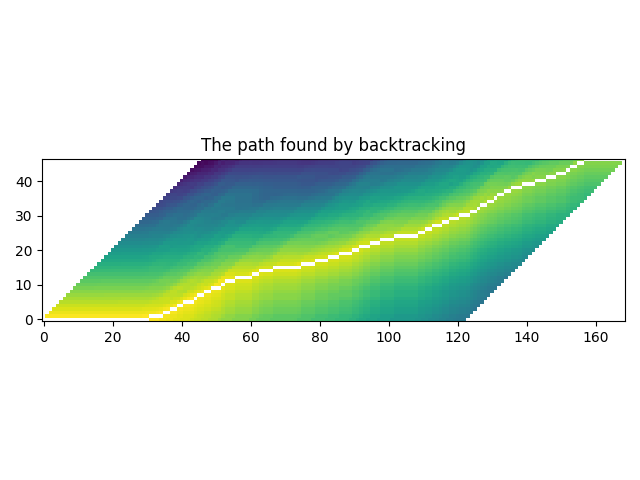
좋습니다.
경로 분할#
지금 이 경로는 같은 라벨의 반복이 포함되어 있기 때문에 이를 병합하여 원본 정답 스크립트와 가깝게 만들어봅시다.
다수의 경로 지점들을 병합할 때 단순하게, 병합된 분할의 평균 확률을 취합니다.
# 라벨을 병합함
@dataclass
class Segment:
label: str
start: int
end: int
score: float
def __repr__(self):
return f"{self.label}\t({self.score:4.2f}): [{self.start:5d}, {self.end:5d})"
@property
def length(self):
return self.end - self.start
def merge_repeats(path):
i1, i2 = 0, 0
segments = []
while i1 < len(path):
while i2 < len(path) and path[i1].token_index == path[i2].token_index:
i2 += 1
score = sum(path[k].score for k in range(i1, i2)) / (i2 - i1)
segments.append(
Segment(
transcript[path[i1].token_index],
path[i1].time_index,
path[i2 - 1].time_index + 1,
score,
)
)
i1 = i2
return segments
segments = merge_repeats(path)
for seg in segments:
print(seg)
| (1.00): [ 0, 31)
I (0.78): [ 31, 35)
| (0.80): [ 35, 37)
H (1.00): [ 37, 39)
A (0.96): [ 39, 41)
D (0.65): [ 41, 44)
| (1.00): [ 44, 45)
T (0.55): [ 45, 47)
H (1.00): [ 47, 49)
A (0.03): [ 49, 52)
T (1.00): [ 52, 53)
| (1.00): [ 53, 56)
C (0.97): [ 56, 61)
U (1.00): [ 61, 63)
R (0.75): [ 63, 67)
I (0.88): [ 67, 75)
O (0.99): [ 75, 79)
S (1.00): [ 79, 83)
I (0.89): [ 83, 86)
T (0.78): [ 86, 90)
Y (0.70): [ 90, 92)
| (0.66): [ 92, 95)
B (1.00): [ 95, 98)
E (1.00): [ 98, 102)
S (1.00): [ 102, 109)
I (1.00): [ 109, 111)
D (0.93): [ 111, 113)
E (0.66): [ 113, 116)
| (1.00): [ 116, 118)
M (0.67): [ 118, 121)
E (0.67): [ 121, 124)
| (0.49): [ 124, 126)
A (1.00): [ 126, 127)
T (0.50): [ 127, 129)
| (0.51): [ 129, 131)
T (1.00): [ 131, 132)
H (1.00): [ 132, 134)
I (0.76): [ 134, 136)
S (0.36): [ 136, 139)
| (0.50): [ 139, 143)
M (1.00): [ 143, 146)
O (1.00): [ 146, 149)
M (1.00): [ 149, 152)
E (1.00): [ 152, 153)
N (0.66): [ 153, 155)
T (0.51): [ 155, 157)
| (0.96): [ 157, 169)
시각화#
def plot_trellis_with_segments(trellis, segments, transcript):
# 경로와 함께 trellis를 그리기 위해, 'nan' 값을 이용합니다.
trellis_with_path = trellis.clone()
for i, seg in enumerate(segments):
if seg.label != "|":
trellis_with_path[seg.start : seg.end, i] = float("nan")
fig, [ax1, ax2] = plt.subplots(2, 1, sharex=True)
ax1.set_title("Path, label and probability for each label")
ax1.imshow(trellis_with_path.T, origin="lower", aspect="auto")
for i, seg in enumerate(segments):
if seg.label != "|":
ax1.annotate(seg.label, (seg.start, i - 0.7), size="small")
ax1.annotate(f"{seg.score:.2f}", (seg.start, i + 3), size="small")
ax2.set_title("Label probability with and without repetation")
xs, hs, ws = [], [], []
for seg in segments:
if seg.label != "|":
xs.append((seg.end + seg.start) / 2 + 0.4)
hs.append(seg.score)
ws.append(seg.end - seg.start)
ax2.annotate(seg.label, (seg.start + 0.8, -0.07))
ax2.bar(xs, hs, width=ws, color="gray", alpha=0.5, edgecolor="black")
xs, hs = [], []
for p in path:
label = transcript[p.token_index]
if label != "|":
xs.append(p.time_index + 1)
hs.append(p.score)
ax2.bar(xs, hs, width=0.5, alpha=0.5)
ax2.axhline(0, color="black")
ax2.grid(True, axis="y")
ax2.set_ylim(-0.1, 1.1)
fig.tight_layout()
plot_trellis_with_segments(trellis, segments, transcript)
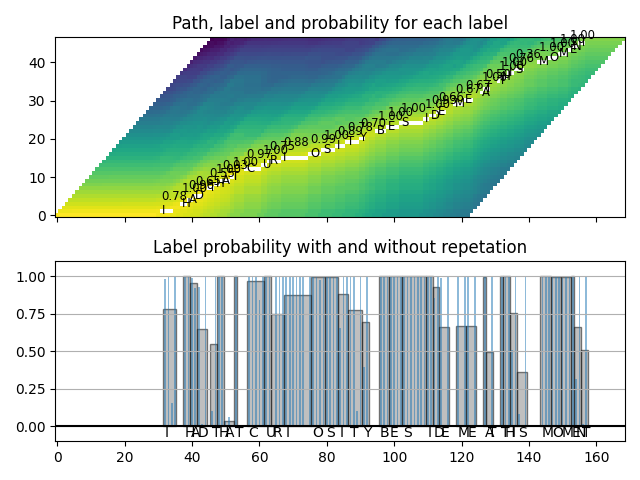
좋습니다.
여러 분할을 단어로 병합#
지금 단어로 병합해봅시다. wav2vec2 모델은 '|' 을 단어 경계로 사용합니다.
그래서 '|' 이 등장할 때마다 분할을 병합합니다.
그러고 나서 최종적으로 원본 오디오를 분할된 오디오로 분할하고 이를 들어 분할이 옳게 되었는지 확인합니다.
# 단어 병합
def merge_words(segments, separator="|"):
words = []
i1, i2 = 0, 0
while i1 < len(segments):
if i2 >= len(segments) or segments[i2].label == separator:
if i1 != i2:
segs = segments[i1:i2]
word = "".join([seg.label for seg in segs])
score = sum(seg.score * seg.length for seg in segs) / sum(seg.length for seg in segs)
words.append(Segment(word, segments[i1].start, segments[i2 - 1].end, score))
i1 = i2 + 1
i2 = i1
else:
i2 += 1
return words
word_segments = merge_words(segments)
for word in word_segments:
print(word)
I (0.78): [ 31, 35)
HAD (0.84): [ 37, 44)
THAT (0.52): [ 45, 53)
CURIOSITY (0.89): [ 56, 92)
BESIDE (0.94): [ 95, 116)
ME (0.67): [ 118, 124)
AT (0.66): [ 126, 129)
THIS (0.70): [ 131, 139)
MOMENT (0.88): [ 143, 157)
시각화#
def plot_alignments(trellis, segments, word_segments, waveform, sample_rate=bundle.sample_rate):
trellis_with_path = trellis.clone()
for i, seg in enumerate(segments):
if seg.label != "|":
trellis_with_path[seg.start : seg.end, i] = float("nan")
fig, [ax1, ax2] = plt.subplots(2, 1)
ax1.imshow(trellis_with_path.T, origin="lower", aspect="auto")
ax1.set_facecolor("lightgray")
ax1.set_xticks([])
ax1.set_yticks([])
for word in word_segments:
ax1.axvspan(word.start - 0.5, word.end - 0.5, edgecolor="white", facecolor="none")
for i, seg in enumerate(segments):
if seg.label != "|":
ax1.annotate(seg.label, (seg.start, i - 0.7), size="small")
ax1.annotate(f"{seg.score:.2f}", (seg.start, i + 3), size="small")
# 원본 waveform
ratio = waveform.size(0) / sample_rate / trellis.size(0)
ax2.specgram(waveform, Fs=sample_rate)
for word in word_segments:
x0 = ratio * word.start
x1 = ratio * word.end
ax2.axvspan(x0, x1, facecolor="none", edgecolor="white", hatch="/")
ax2.annotate(f"{word.score:.2f}", (x0, sample_rate * 0.51), annotation_clip=False)
for seg in segments:
if seg.label != "|":
ax2.annotate(seg.label, (seg.start * ratio, sample_rate * 0.55), annotation_clip=False)
ax2.set_xlabel("time [second]")
ax2.set_yticks([])
fig.tight_layout()
plot_alignments(
trellis,
segments,
word_segments,
waveform[0],
)
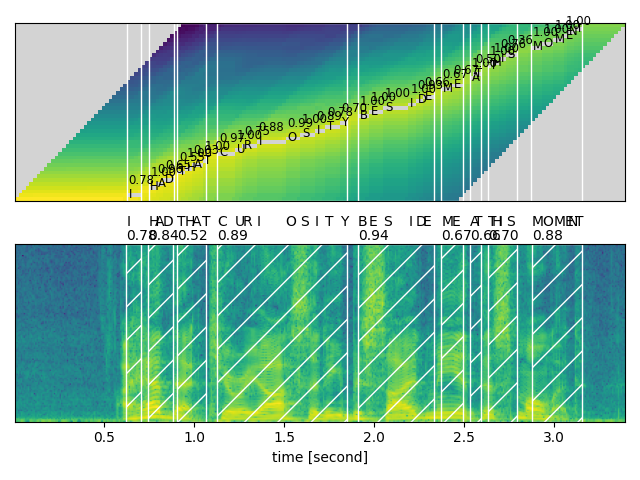
오디오 샘플#
def display_segment(i):
ratio = waveform.size(1) / trellis.size(0)
word = word_segments[i]
x0 = int(ratio * word.start)
x1 = int(ratio * word.end)
print(f"{word.label} ({word.score:.2f}): {x0 / bundle.sample_rate:.3f} - {x1 / bundle.sample_rate:.3f} sec")
segment = waveform[:, x0:x1]
return IPython.display.Audio(segment.numpy(), rate=bundle.sample_rate)
# 각 분할에 해당하는 오디오 생성
print(transcript)
IPython.display.Audio(SPEECH_FILE)
|I|HAD|THAT|CURIOSITY|BESIDE|ME|AT|THIS|MOMENT|
display_segment(0)
I (0.78): 0.624 - 0.704 sec
display_segment(1)
HAD (0.84): 0.744 - 0.885 sec
display_segment(2)
THAT (0.52): 0.905 - 1.066 sec
display_segment(3)
CURIOSITY (0.89): 1.127 - 1.851 sec
display_segment(4)
BESIDE (0.94): 1.911 - 2.334 sec
display_segment(5)
ME (0.67): 2.374 - 2.495 sec
display_segment(6)
AT (0.66): 2.535 - 2.595 sec
display_segment(7)
THIS (0.70): 2.635 - 2.796 sec
display_segment(8)
MOMENT (0.88): 2.877 - 3.159 sec
결론#
이번 튜토리얼에서, torchaudio의 wav2vec2 모델을 사용하여 강제 정렬을 위한 CTC 분할을 수행하는 방법을 살펴보았습니다.
Total running time of the script: (0 minutes 11.393 seconds)
